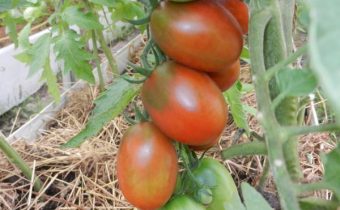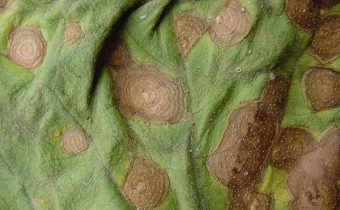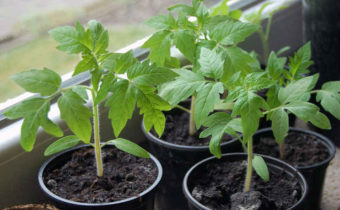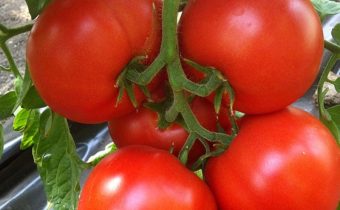What kind of soil loves tomato - structure, acidity, fertility
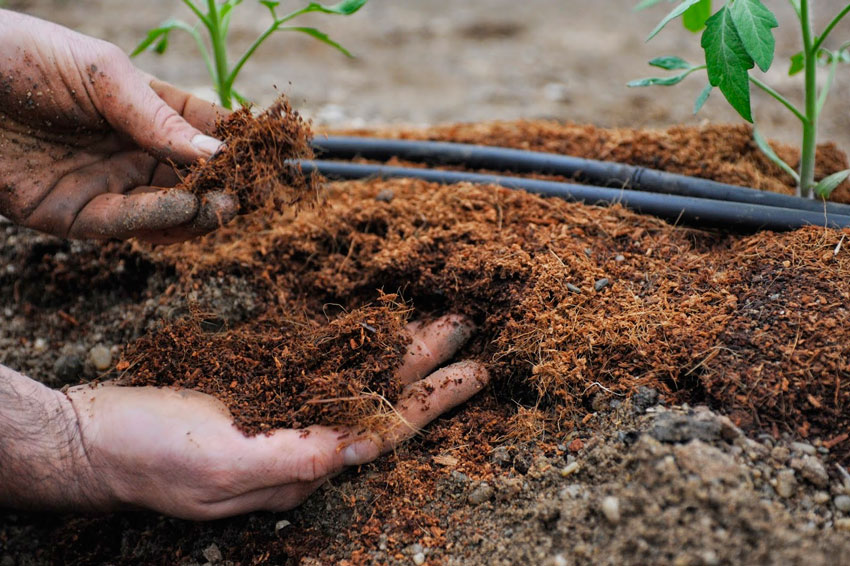
Tomatoes - a culture that is demanding of light, heat and soil. In the climate of the Russian Federation, efforts are required to ensure proper care and to bring the soil closer to optimal qualities for active root development.
- Basic requirements for soil for growing tomatoes
- Soil acidity for growing tomatoes
- Determine the acidity of the soil
- How to adjust acidity
- Soil moisture
- Qualitative composition of soil for growing tomatoes
- How to organize a bed in the open field for tomatoes
- Gardener's mistakes in preparing and maintaining the soil for tomatoes
- Conclusion
The land for tomato must meet certain characteristics so that you get a rich harvest of ripe and environmentally friendly vegetables.
Basic requirements for soil for growing tomatoes
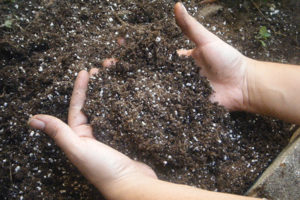
Requirements for the composition of the soil for the cultivation of tomatoes consist of the needs of the culture. The main indicators to be assessed are:
- acidity;
- soil structure;
- humidity.
Tomatoes require rich in vitamins and minerals soils to effectively grow and bear fruit.
Growing tomatoes in open ground should occur in heated land with sufficient lighting.
The powerful root system of tomatoes has many branches and processes that grow in a wide range around the bush. They provide the plant with all the necessary nutrients, minerals and trace elements contained in the soil. The process of growth of tomatoes, the number and volume of fruits depend on the qualitative composition of the soil.
Soil acidity for growing tomatoes
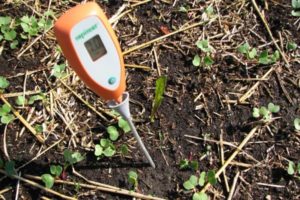
One of the most important indicators that should be given great attention is soil acidity. The plot where tomatoes are planted should have a pH in the range from 6 to 6.8. This is the optimal value, which is detected empirically.
Soil acidity is its chemical property reaction, which is determined by soil in the form of hydrogen concentration. The indicators obtained in the course of scientific experiments are classified as follows:
| Soil character | Acidic | Sour | Subacid | Neutral |
| pH | 4,5 | 4,5-5,0 | 5,0-5,5 | 5,5-7,0 |
Thus, we see that tomatoes prefer neutral soils. That is, if you have a sour soil in the area where you grow tomatoes, you should neutralize the acidity in various ways.
Determine the acidity of the soil
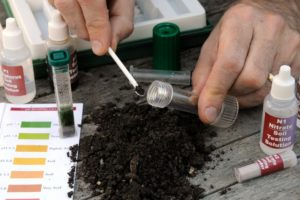
To determine the acidity of the soil for tomatoes, it is best to perform a chemical analysis in a special soil science laboratory. Experienced specialists will perform calculations on high-precision equipment and determine not only the acidity index, but also the ratio of nitrogen, potassium, phosphorus and other elements necessary for tomatoes.
Soil acidity can also be defined:
- special device pH meter. The device is stuck into the ground and shows the value of acidity with an accuracy of tenths;
- litmus paper. In specialized stores sold ready-made indicator sets for determining the acidity of the soil. To carry out the analysis, the soil should be taken in several places, and placed in distilled water. Each sample is wrapped in a bandage or gauze. 5 minutes after immersion, a litmus test is placed in the water. Acidity is determined by color;
The pink-orange color of the litmus indicator indicates an acidic reaction, the yellow shade is slightly acid, the greenish color is neutral.
- folk ways. For crops and weeds growing in the garden, as well as for independently conducted chemical experiments, as a result of which homemade indicators are prepared;
- reaction to the mixing of water, chalk and earth. The soil collection is placed in a bottle or jar, mixed with chalk powder and filled with water. Top tensioning fingertip or glove. Filling rubber products with a volume indicates an acidic soil reaction.
The most accurate and optimal way to determine the acidity of the soil - laboratory. If you have such an opportunity, use it.
How to adjust acidity
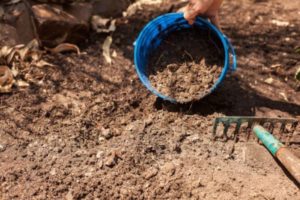
If you find that you have a high acidity of the soil, you need to make lime. The main rules of liming are:
- the procedure should be carried out in the spring before planting seedlings or in the fall after harvesting;
- the area must be free from weeds and other plants;
- lime mixture should be thoroughly crushed;
- for liming one should choose a windless clear day;
- lime is poured in a thin layer on the ground.
Digging the ground mass to a depth of 20 cm will ensure the mixing of earth and lime, as well as the introduction of the composition into the deep layers. As a result, neutralization reactions occur in the soil.
Soil moisture
Important attention should be paid to the natural moisture content of the soil. Tomatoes prefer well aerated and moist soil. Do not plant tomatoes in marshy and clay areas. Moistening will entail the rotting of the roots.
Choose a plot for planting tomatoes where the groundwater is low. To determine the depth of the upper aquifer, assess the drainage ditches and depressions in the soil. If after the rain in the ditches there is high water that does not go away for a long time, this means high ground water. To grow tomatoes, select elevated areas.
Regular watering should be organized. In dry weather, tomatoes are watered once a day after noon. For irrigation, use distilled water.
Qualitative composition of soil for growing tomatoes
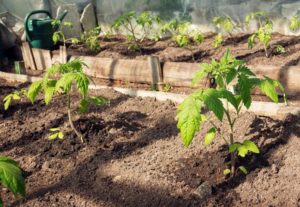
The land on which they will plant, tomatoes must contain a sufficient amount:
- potassium;
- phosphorus;
- nitrogen.
The soil should also include such elements as manganese, zinc, selenium.
Soil for growing tomatoes must have a loose structure. This ensures optimum absorption by the root processes of moisture and all the necessary nutrients. Loose soil well distributes moisture and provides the necessary aeration. Swampy or clayey soils can cause rotting of the root system due to excessive moisture.
The plot where tomatoes grow should be weeded regularly to prevent weed growth. They not only take away valuable moisture and nutrients from the crop, create a shortage of sunlight, but can also dump their seeds into the soil. In order to prevent this, it is necessary to remove weeds at the first shoots.
To provide the soil for growing potassium to tomatoes, you need to make potassium salt or wood ash. For the introduction of nitrogen using ammonium nitrate. Phosphorus is applied using the finished fertilizer superphosphate.
Another important soil requirement for growing tomatoes is the absence of pests. Larvae in the ground, harmful insects can destroy the entire crop. You should regularly carry out preventive measures against the appearance of fleas, aphids, midges, mold fungi and viruses. This is provided by ready-made chemical solutions, which are sold in specialized stores, or is achieved by popular methods.
How to organize a bed in the open field for tomatoes
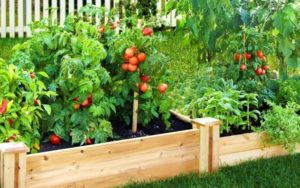
Experienced gardeners use high beds for growing tomatoes with filling them with optimum soil composition. To do this, on the site choose a well-lit place without drafts, on which:
- mount a box of planks or other material at hand up to 30 cm in height. It is important that the joints are securely attached to each other in order to prevent soil leaching;
- garden land is brought into the box. You can dig it near. The height of the layer is not less than 15 cm;
- peat mixture is poured with an acidity of 6.5 with a height of about 5 cm;
- make river sand a layer of 1-2 cm;
- fall asleep wood ash;
- make mature compost or rotted manure with a layer of 10 cm.
All the components are digging up with a bayonet spade to a depth of 30 cm. As a result, you got a primer, which has all the ingredients for a rich crop of tomatoes. This composition can be used for the preparation of seedlings, and for growing tomatoes in greenhouse conditions.
Gardener's mistakes in preparing and maintaining the soil for tomatoes
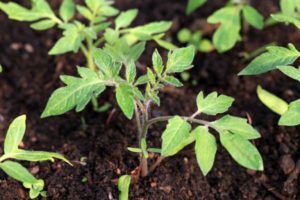
Some gardeners underestimate the importance of soil acidity for growing tomatoes and its qualitative composition. The most common errors in the care of the soil are:
- lack of control over acidity. Tomatoes will not produce a bountiful harvest, if you do not follow the acidity. Tomatoes prefer neutral soils;
- unsystematic application of organic fertilizers. Adding mullein, litter and compost alters the acidity of the soil. It should adhere to the recommendations of agronomists on the timing of the introduction of organic matter;
- failure to make ready-made supplements or natural nutritional infusions. Neglecting the dressing of tomatoes also has a detrimental effect on their development and fruit formation. The soil is quickly depleted and the plant is deficient in nutrients;
- fertilizer compost poor quality. Adding compost to the soil, which uses unacceptable components, affect the quality of the soil. When organizing a compost pit, you should not store pets' feces, colored glossy paper, sour peat into it. Time should also be given to allow the compost to re-burn;
- entering into the soil of fresh manure. The use of fresh mullein or bird droppings in its pure form is fraught with increased acidic or alkaline reactions of the soil. It takes time to wait for chemical neutralization and decomposition reactions to occur in the manure.
Gardeners should also pay attention to soil moisture.
Conclusion
To obtain a rich harvest of personally grown tomatoes in greenhouses or open ground, it is necessary to carefully monitor the composition and acidity of the soil. Culture grows well and forms many of the ovaries in neutral soil. If the acidity index deviates, neutralization measures should be taken.


